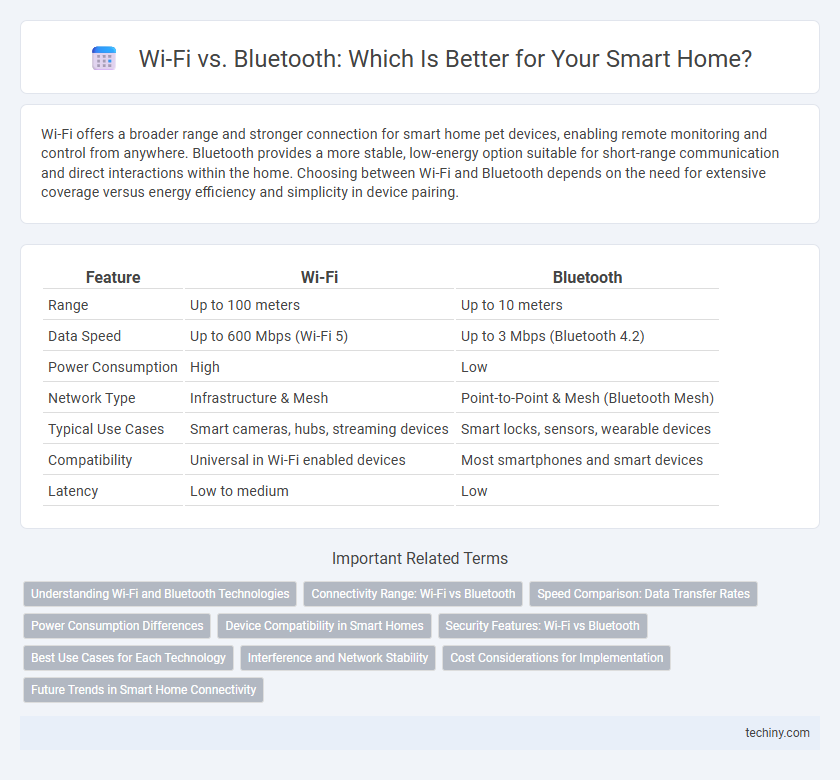Wi-Fi offers a broader range and stronger connection for smart home pet devices, enabling remote monitoring and control from anywhere. Bluetooth provides a more stable, low-energy option suitable for short-range communication and direct interactions within the home. Choosing between Wi-Fi and Bluetooth depends on the need for extensive coverage versus energy efficiency and simplicity in device pairing.
Table of Comparison
| Feature | Wi-Fi | Bluetooth |
|---|---|---|
| Range | Up to 100 meters | Up to 10 meters |
| Data Speed | Up to 600 Mbps (Wi-Fi 5) | Up to 3 Mbps (Bluetooth 4.2) |
| Power Consumption | High | Low |
| Network Type | Infrastructure & Mesh | Point-to-Point & Mesh (Bluetooth Mesh) |
| Typical Use Cases | Smart cameras, hubs, streaming devices | Smart locks, sensors, wearable devices |
| Compatibility | Universal in Wi-Fi enabled devices | Most smartphones and smart devices |
| Latency | Low to medium | Low |
Understanding Wi-Fi and Bluetooth Technologies
Wi-Fi technology operates on higher frequency bands and supports longer range connectivity, making it ideal for smart home devices requiring constant internet access and high data throughput. Bluetooth technology, with its low power consumption and short-range capabilities, excels in connecting smaller devices like sensors and remote controls within a localized smart home environment. Understanding the key differences in range, power usage, and data transfer rates between Wi-Fi and Bluetooth is crucial for optimizing smart home device performance and network efficiency.
Connectivity Range: Wi-Fi vs Bluetooth
Wi-Fi offers a significantly greater connectivity range, typically up to 150 feet indoors, compared to Bluetooth's shorter range of around 30 feet. This extended coverage makes Wi-Fi ideal for controlling smart home devices spread throughout larger homes or multiple rooms. Bluetooth, with its limited range, suits close-proximity devices like smart locks or speakers within a single room.
Speed Comparison: Data Transfer Rates
Wi-Fi offers significantly higher data transfer rates compared to Bluetooth, with speeds reaching up to 1 Gbps in Wi-Fi 6, whereas Bluetooth 5.2 maxes out around 2 Mbps. This makes Wi-Fi ideal for bandwidth-intensive smart home applications such as video streaming and large file transfers. Bluetooth's lower speed is sufficient for simple device communication like sensors and smart locks, prioritizing energy efficiency over throughput.
Power Consumption Differences
Wi-Fi consumes significantly more power than Bluetooth, making it less suitable for low-energy smart home devices like sensors and remote controls. Bluetooth Low Energy (BLE) is specifically designed for minimal power usage, extending battery life in smart locks, thermostats, and wearable devices. Power consumption differences directly impact device uptime and maintenance frequency in smart home ecosystems.
Device Compatibility in Smart Homes
Wi-Fi supports a broader range of smart home devices, including cameras, thermostats, and smart speakers, due to its higher data capacity and extended range. Bluetooth is ideal for short-range, low-power devices like smart locks and sensors, offering seamless pairing with smartphones and tablets. Choosing Wi-Fi or Bluetooth depends on the device's connectivity needs and compatibility within the smart home ecosystem.
Security Features: Wi-Fi vs Bluetooth
Wi-Fi offers robust security protocols such as WPA3 encryption, providing strong protection against unauthorized access and data interception. Bluetooth employs adaptive frequency hopping and encryption methods like AES-CCM to safeguard short-range communications but is generally more vulnerable to attacks like bluesnarfing in less secure implementations. Choosing Wi-Fi for smart home security ensures comprehensive network-level defenses, while Bluetooth suits secure device-to-device connections with limited range.
Best Use Cases for Each Technology
Wi-Fi excels in smart home applications requiring high-speed data transfer and long-range connectivity, such as video streaming from security cameras and controlling multiple devices across large areas. Bluetooth is ideal for low-power, short-range communication like connecting smart locks, sensors, and wearable devices that prioritize battery efficiency. Choosing the appropriate technology depends on device function, range needs, and energy consumption for optimal smart home performance.
Interference and Network Stability
Wi-Fi offers broader coverage and higher data throughput but is more susceptible to interference from devices operating on similar 2.4 GHz and 5 GHz frequencies, such as microwaves and cordless phones, which can impact network stability. Bluetooth uses frequency hopping spread spectrum (FHSS) technology, minimizing interference by rapidly switching frequencies within the 2.4 GHz band, enhancing connection reliability in congested environments. For smart home applications requiring stable, low-latency connections with minimal interference, Bluetooth often provides better performance in device-to-device communication, while Wi-Fi excels in high-bandwidth, whole-home network coverage.
Cost Considerations for Implementation
Wi-Fi smart home devices typically incur higher costs due to increased hardware requirements and more complex installation processes, whereas Bluetooth devices offer a more budget-friendly option with simpler setup and lower power consumption. The price difference is influenced by Wi-Fi's broader range and faster data transfer capabilities, which demand more expensive components. For cost-sensitive smart home projects, Bluetooth provides an economical solution without sacrificing basic connectivity and control functions.
Future Trends in Smart Home Connectivity
Wi-Fi and Bluetooth will both play pivotal roles in the future of smart home connectivity, with Wi-Fi enhancing high-speed data transfer for bandwidth-intensive devices and Bluetooth advancing low-power communication for efficient sensor networks. Innovations such as Wi-Fi 6E and Bluetooth 5.3 are driving improved range, reduced latency, and greater device capacity, enabling seamless integration of smart appliances, lighting, and security systems. The convergence of these technologies supports the development of interoperable smart home ecosystems, fostering greater automation and user customization.
Wi-Fi vs Bluetooth Infographic

 techiny.com
techiny.com